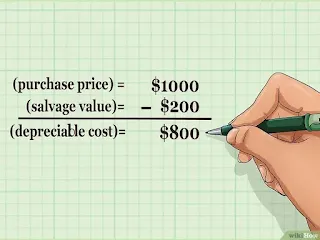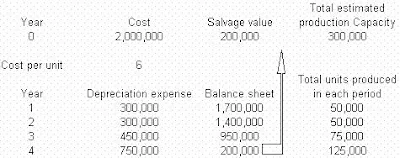How To Calculate Depreciation Of Fixed Assets
Fixed assets are assets which are permanent in nature and create revenue for business. They can last for last for a long period of time. Fixed assets of a business lose value or are said to depreciate with usage. Depreciation can be defined as a reduction in the economic service potential of an asset as a result wears, tears, usage and passage of time. It can also be said to be a the permanent and continuous decrease in the quality and value of an asset. The allocation of the cost of a fixed asset over its estimated useful life is a loss and must be taken into consideration when preparing the profit and loss accounts. When fixed assets are sold, the parts cost not recovered is termed DEPRECIATION.
The formula for depreciation is: COST - ESTIMATED VALUE
YEAR OF USEFUL LIFE
ILLUSTRATION:
The cost of a machine is $10,000. The residual value is $4,000. It is expected to last for 4 years, what is the cost of depreciation?
= $10,000 - $4,000
4
$6000 =$1,500
4
ALSO READ: Meaning Of Assets, Fixed And Current Assets
REASONS FOR CHARGING DEPRECIATION
- Since depreciation is a charge against profit, the tax to be paid on the profit by the firm will be reduced
- The amount charged as depreciation can be used for the replacement of the asset at the end of the useful life.
- It shows the marching concept, the cost of assets are spread over its useful life.
- To arrive at a profit figure which can be compared with similar business which is not having the advantage of owing the asset as the business charging depreciation.
- It enables the business to measure the degree of forecast in relation to estimating the amount of depreciation.
- WEAR AND TEAR: An asset may depreciate as a result of constant usage. Physical factors like erosion, dampness, rust and decay can cause an asset to reduce in value.
- OBSOLESCENCE: An asset can become obsolete due to changes in technology. When this occurs, it is due for replacement. A very good example is the steam engine train which was replaced by diesel engine train.
- PASSAGE OF TIME: Depreciation occurs in some assets with the effusion of time e.g Leaseholds, patents and copyrights
- DEPLETION: Some natural resources like gold, oil or tin deposits become worthless when the deposits have been depleted. They are called wasting assets. The more they are extracted, the less the reserve.
- INADEQUACY: As a result of expansion in the productive of a company an asset may become too small or inadequate and thus required replacement for bigger ones.
WHY SHOULD SMALL BUSINESSES CARE TO RECORD DEPRECIATION?
So now we know the meaning of depreciation, the methods used to calculate them, inputs required to calculate them and also we saw examples of how to calculate them. Let’s find out as to why the small businesses should care to record depreciation.
As we already know the purpose of depreciation is to match the cost of the fixed asset over its productive life to the revenues the business earns from the asset. It is very difficult to directly link the cost of the asset to revenues, hence, the cost is usually assigned to the number of years the asset is productive.
ELEMENT OF DEPRECIATION/ FACTORS TO BE CONSIDERED IN THE COMPUTATION OF DEPRECIATION
- ORIGINAL COST: This is the cost incurred purchasing, installation and cost of carriage.
- ESTIMATED LIFE: This is the scrap value. The amount which can be recovered when the asset is sold at the end of useful life.
- ESTIMATED VALUE: The expected number of year through which an asset can last.
- METHOD OF DEPRECIATION: This is the method that is to be used consistently in depreciating the asset through its life span.
METHODS OF DEPRECIATION
There are various methods of depreciating fixed assets. These are;
- Straight line depreciation
- Double declining method
- Annuity method
- Unit of production depreciation
- Retirement and Replacement method
- Sum of the year digit method
- Depletion unit method
- Insurance policy system
- Revaluation.
SUM-OF-YEAR METHOD
Depreciation In Year
= ((n-i+1) / n!) * (total acquisition cost - salvage value)
Example: For $2 million, Company ABC purchased a machine that will have an estimated useful life of five years. The company also estimates that in five years, the company will be able to sell it for $200,000 for scrap parts.
n! = 1+2+3+4+5 = 15
The sum-of-year depreciation method produces a variable depreciation expense. At the end of the useful life of the asset, its accumulated depreciation is equal to the accumulated depreciation under the straight-line depreciation.
ALSO READ: Types Of Accounting
ALSO READ: Types Of Accounting
STRAIGHT-LINE DEPRECIATION
The simplest and most commonly used method, straight-line depreciation is calculated by taking the purchase or acquisition price of an asset, subtracting the salvage value (value at which it can be sold once the company no longer needs it) and dividing by the total productive years for which the asset can reasonably be expected to benefit the company (or its useful life).
Example: For $2 million, Company ABC purchased a machine that will have an estimated useful life of five years. The company also estimates that in five years, the company will be able to sell it for $200,000 for scrap parts.
Depreciation Expense = Total Acquisition Cost – Salvage Value / Useful Life
Straight-line depreciation produces a constant depreciation expense. At the end of the asset's useful life, the asset is accounted for in the balance sheet at its salvage value.
UNIT-OF-PRODUCTION DEPRECIATION
This method provides for depreciation by means of a fixed rate per unit of production. Under this method, one must first determine the cost per one production unit and then multiply that cost per unit with the total number of units the company produced within an accounting period to determine its depreciation expense.
Depreciation Expense = Total Acquisition Cost - Salvage Value / Estimated Total Units
Estimated total units = the total units this machine can produce over its lifetime
Depreciation expense = depreciation per unit * number of units produced during an accounting period
Example:
Company ABC purchased a machine for $2 million that can produce 300,000 products over its useful life. The company estimates that this machine has a salvage value of $200,000.
Unit-of-production depreciation produces a variable depreciation expense and is more reflective of production-to-cost.
At the end of its useful life, the asset's accumulated depreciation is equal to its total cost minus its salvage value. Furthermore, its accumulated production units equal the total estimated production capacity. One of the drawbacks of this method is that if the units of products decrease (due to slowing demand for the product, for example), the depreciation expense also decreases. This results in an overstatement of reported income and asset value.
ALSO READ: Depreciation Of Fixed Assets
DOUBLE-DECLINING-BALANCE METHOD
The DDB method simply doubles the straight-line depreciation amount that is taken in the first year, and then that same percentage is applied to the un-depreciated amount in subsequent years.
DDB In year i = (2 / n) * (total acquisition cost - accumulated depreciation)
n = number of years
Example
For $2 million, Company ABC purchased a machine that will have an estimated useful life of five years. The company also estimates that in five years the company will be able to sell it for $200,000 for scrap parts.
The double-declining-balance method produces a very aggressive depreciation schedule. The asset cannot be depreciated beyond its salvage value.
At the end of its useful life, the asset's accumulated depreciation is equal to its total cost minus its salvage value. Furthermore, its accumulated production units equal the total estimated production capacity. One of the drawbacks of this method is that if the units of products decrease (due to slowing demand for the product, for example), the depreciation expense also decreases. This results in an overstatement of reported income and asset value.
ALSO READ: Depreciation Of Fixed Assets
DOUBLE-DECLINING-BALANCE METHOD
The DDB method simply doubles the straight-line depreciation amount that is taken in the first year, and then that same percentage is applied to the un-depreciated amount in subsequent years.
DDB In year i = (2 / n) * (total acquisition cost - accumulated depreciation)
n = number of years
Example
For $2 million, Company ABC purchased a machine that will have an estimated useful life of five years. The company also estimates that in five years the company will be able to sell it for $200,000 for scrap parts.
The double-declining-balance method produces a very aggressive depreciation schedule. The asset cannot be depreciated beyond its salvage value.
The method to be adopted is a matter of policy on the part of management of the business. However, consistency must be applied. This means that all similar assets should be depreciated by the same method and the same method should be used every year.















